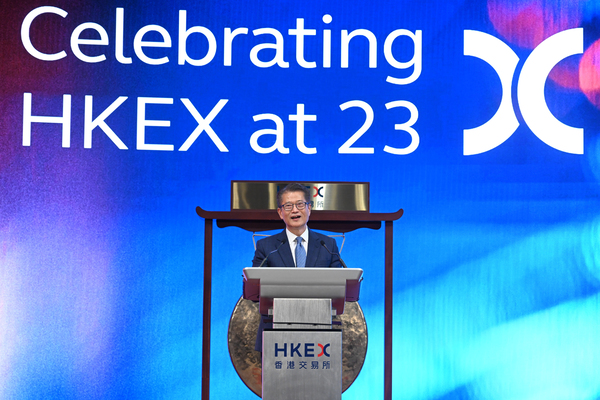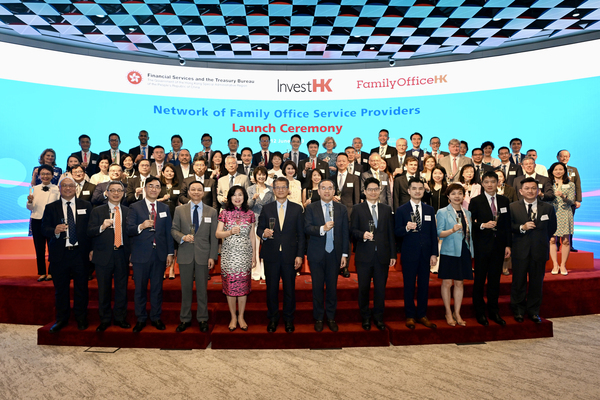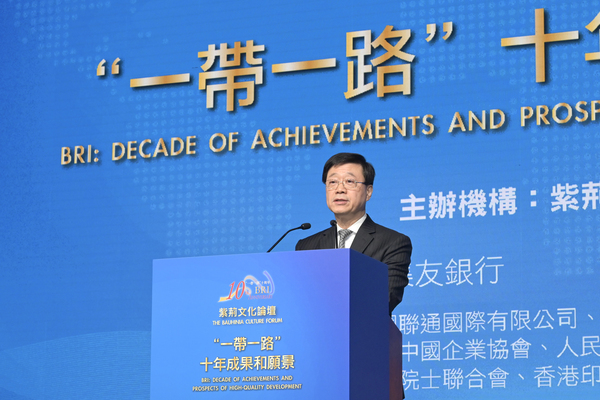
When I spoke to you at last year’s conference, I had only assumed the office of the Chief Executive of the Hong Kong Special Administrative Region for less than a month. I stressed that the Government under my leadership would be a “results-oriented” one.
One year on, as we approach this Government’s first anniversary, allow me to touch on a few areas that speak to our belief in the primacy of “results”, our pledge to work “pragmatically, and passionately, for Hong Kong – and our country”.
Attracting talent and enterprises
As we emerge from the COVID-19 pandemic, Hong Kong is striving our best to make up for lost time.
I outlined in my Policy Address last October an array of new and unprecedented initiatives to proactively and aggressively compete for enterprises and talent. To get things done. To achieve results.
We introduced the Top Talent Pass Scheme and enhanced various talent schemes about half a year ago. The enhanced talent admission regime had received, in half a year, 84,000 applications by the end of May, and we’ve approved some 49,000 of them. This is solid proof of Hong Kong’s attractiveness for global talent to come and settle, live and work in.
The new Office for Attracting Strategic Enterprises has already met more than 150 enterprises from around the world in just the past six months. We aim to attract at least 1,130 companies to set up or expand their operations in Hong Kong from 2023 to 2025.
By the way, that 49,000 approved talent means what? I set a target of attracting 35,000 talent a year, that 49,000 means I have beat it almost by a double, by the end of the year, looking at this trend. That tells Hong Kong’s attractiveness.
Telling good stories of HK
The pandemic has made it a global trend to “work from home”, and in many aspects, working from home has proven to improve work efficiency. However, my team and I don’t just “work from home” in attracting talent and enterprises. We have travelled abroad to tell the world that Hong Kong is back in business, back in the business of creating opportunities, back on the world’s centre stage.
Last November, I made my first visit overseas as the Chief Executive. At the annual APEC (Asia-Pacific Economic Cooperation) Economic Leaders’ Meeting and my subsequent visit to Thailand, I reassured our trading partners of Hong Kong’s commitment to regional economic co-operation. More importantly, I told the business and political leaders there about the uniqueness of Hong Kong, where the China advantage and the global advantage converge in a single city.
In February, I visited Saudi Arabia and the United Arab Emirates. The Middle East is an area of increasing importance to the Belt & Road Initiative, a key national strategy personally launched by President Xi Jinping 10 years ago. During my visit, we signed 13 MOUs (memoranda of understanding) and co-operation letters of intent. The Dubai Chambers announced the establishment of a new office in Hong Kong.
We kept seeing good results of stronger relations between Hong Kong and the Middle East. Just yesterday, the Future Investment Initiative Institute, which is headquartered in Saudi Arabia, announced that it will host its inaugural PRIORITY Asia Summit in Hong Kong this December.
Since our visits, I have personally welcomed potential investors from Thailand, the Middle East and other economies. I am pleased to note that many of them have shown keen interest in investing in Hong Kong.
Maintaining HK’s international status and connections
Hong Kong’s presence in international organisations is important to our status as a cosmopolitan city, as well as our continuous growth as one of the world’s freest economies.
Since 1997, we have continued as a separate member of WTO (World Trade Organization) and APEC respectively under the name “Hong Kong, China”. This is another piece of solid evidence that shows the central government’s strong and long-standing support for Hong Kong to maintain its role as an international city, under the unique principle of “one country, two systems”.
In just the past two months, four of the principal officials on my team travelled to different parts of the world to take part in important international conferences on behalf of Hong Kong. The Secretary for Labour & Welfare was in Geneva for the International Labour Conference. The Secretary for Health was also in Geneva for the WHO (World Health Organization)’s World Health Assembly. The Secretary for Transport & Logistics and the Secretary for Commerce & Economic Development were in Detroit for APEC ministerial meetings.
The commerce secretary also travelled to Paris for the OECD (Organisation for Economic Co-operation & Development)’s annual Ministerial Council Meeting. At the trade session, he spoke of the importance of fighting against protectionism, highlighting Hong Kong’s experience in enabling SMEs (small and medium enterprises) to drive sustainable economic development.
Continued commitment to regional co-operation
Hong Kong champions multilateralism and accords high priority to establishing partnerships with different economies.
Later this summer, I will lead a high-profile business delegation to a number of ASEAN (Association of Southeast Asian Nations) countries. ASEAN is the world’s fifth-largest economy and has been Hong Kong’s second-largest trade partner since 2010. This visit will be a welcome opportunity to highlight, to our partners in this fast-growing regional bloc, Hong Kong’s manifold advantages as the gateway to the Mainland, especially the Guangdong-Hong Kong-Macao Greater Bay Area (GBA).
It is an opportune time to underline our strengths in regional economic development, and the wide-ranging benefits we can bring, both to ASEAN economies and to RCEP (Regional Comprehensive Economic Partnership), on our proposed accession to the world’s largest free trade agreement.
Ladies and gentlemen, Hong Kong people are known for their benevolence. Just as how we are committed to promoting mutual prosperity, Hong Kong actively contributes to our country’s work in global governance and lends its helping hand to those in need in the global community.
Following the severe earthquakes in Türkiye earlier this year, we sent a 59-strong search and rescue team from Hong Kong all the way to Türkiye’s quake-stricken areas. The team’s valiant effort has helped to save four precious lives. We will continue our liaison with the relevant authorities of the United Nations, on Hong Kong’s establishment of a medium urban search and rescue team for different missions.
Growing HK’s budding strengths
As Hong Kong embarks on the journey from stability to prosperity, we are working to fully unleash our great potential in development in a variety of budding sectors.
Innovation and technology is a policy priority of this term of the Government, and the results are encouraging. In the 2023 IMD (International Institute for Management Development) Smart City Index, Hong Kong finished 19th out of 141 cities. That’s up from 38th place in the previous index, I’m pleased to note.
The Shenzhen-Hong Kong-Guangzhou science and technology cluster has been ranked second globally for three consecutive years in the Global Innovation Index. This highlights the strength of complementarity among GBA cities.
This year, we’ve signed I&T (innovation and technology) co-operation agreements with Shenzhen, Guangdong and Chongqing. More importantly, we have signed, in March, an arrangement with the Mainland’s Ministry of Science & Technology that will expedite Hong Kong’s development as an international I&T centre.
Consolidating HK’s traditional strengths
When it comes to finance, Hong Kong has long been a global leader. Thanks to the 14th Five-Year Plan, our status as an international financial centre and the world’s largest offshore renminbi hub is primed for continuing growth.
Over the past year, Stock Connect has been expanded to include stocks of foreign companies primary listed in Hong Kong under southbound trading and exchange-traded funds. Last month, we welcomed the launch of Swap Connect’s northbound trading.
Just yesterday, HKEX (Hong Kong Exchanges & Clearing) introduced a “Hong Kong Dollar-Renminbi dual counter model” and “dual counter market maker”. This allows investors to trade the same listed security in both Hong Kong dollars and renminbi.
This term of the Government sees promises, too, in financial technology and virtual assets, which draw together our traditional strengths in finance and Hong Kong’s burgeoning I&T sector. Our new licensing regime for virtual assets service providers began operation this month. That makes Hong Kong among the world’s first authorities to introduce a comprehensive regime regulating virtual asset activities. We are committed to ensuring investor protection and market integrity, while managing key risks to financial institutions and encouraging more investors.
In short, the Government is committed to innovative financial and economic development, to pursuing opportunities, wherever they arise.
Closing remarks
Ladies and gentlemen, life in Hong Kong is back to the business, and many pleasures, of entertainment as well. In recent months, we’ve hosted the Rugby Sevens and the largest Art Basel Hong Kong since 2019. The Hong Kong International Dragon Boat Races is returning to Victoria Harbour later this week, in celebration of the Dragon Boat Festival. Also coming to the harbourfront is the brand-new Harbour Chill Carnival, which opens on July 8 in Wan Chai, and will be making a splash with live shows and refreshments for five weekends in a row.
And we’re just getting going, ladies and gentlemen. I am a believer. That’s why I’ve stated in my election manifesto a year ago that we will be “starting a new chapter for Hong Kong together”.
About working together, I feel obliged to point out that both my visits to Thailand and the Middle East were joined by leaders of Hong Kong’s business and professional sectors. This shows their passion for Hong Kong and a high level of team spirit. A clear sense of “togetherness” of the whole community, from both the public and private sectors.
We are all living in a world with growing volatility and tensions in geopolitics. We in Hong Kong must stay united in telling the world all about the good stories of Hong Kong.
Together, we can make a better future for Hong Kong, for our country, and for the world.
A supplement to what has been described as Hong Kong’s strength, a super-connector. Yes, we are, but we are more than a super-connector. We are a value-added super-connector. We have professional services. We have a lot of professional workforce. So we don’t just connect, we add value. We help people to grow and we help people to thrive. We help people to know the way and be successful.
Chief Executive John Lee gave these remarks at the South China Morning Post China Conference Hong Kong 2023 on June 20.




